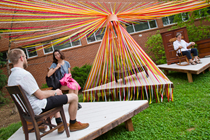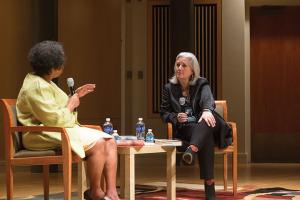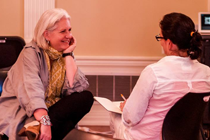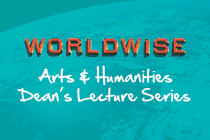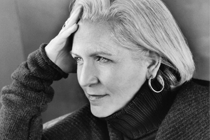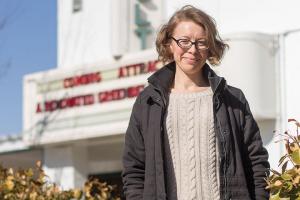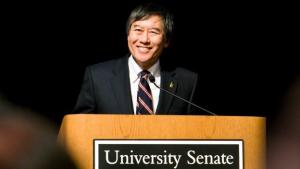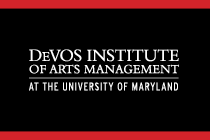BY LAUREN BROWN
PHOTO BY JOHN T. CONSOLI
This week only, the landscape of downtown College Park is a little more whimsical. And thoughtful. And connected.
Students in a new public art and design course have installed five temporary artworks on streets, in open spaces and in other nooks of the city for view May 11–16, in hopes of sparking conversations about the relationship between the university and College Park.
On Monday, passersby paused and drivers turned their heads to stare at the works, such as reflector-covered poles lining a sidewalk, a blown-up globe between a pair of park benches, and three platforms bearing chairs and tables and festooned with a canopy of colored ribbons, on a grassy area just outside City Hall.
Architecture Associate Professor Ronit Eisenbach, with sculptor and art Professor John Ruppert and urban planning Professor Gerrit Knapp, director of the National Center for Smart Growth, taught the “Making Place Work” class to a mix of art, architecture and landscape architecture students.
“We wanted them to think about spicing up College Park a bit, and raise possibilities about what could happen here,” she says.
The course is supported by UMD’s Academy for Innovation and Entrepreneurship andPartnership for Action Learning in Sustainability (PALS) program, in which students and faculty work with local governments in Maryland to solve real community problems.
The students first explored the challenges the city and university are now confronting to make College Park’s downtown more vibrant, diverse and attractive. Then, split into teams, they explored different concepts in the city-campus relationship, such as blurring the boundaries between them or emphasizing the quiet areas or creating a place to mingle. They worked with the property owners—the university, its foundation and the city—to secure short-term use of the spaces, and raced to design and build their visions.
Architecture graduate student Prakruti Hoskere was glad to get experience in collaborating and constructing a design on a budget, and has enjoyed watching people interact with her team’s piece, “Room Garden.”
“I really feel that these projects can help make College Park a better place,” she says.
For more information, visit makingplaceumd.wordpress.com. Passersby can connect via Twitter #CPMakePlace.

